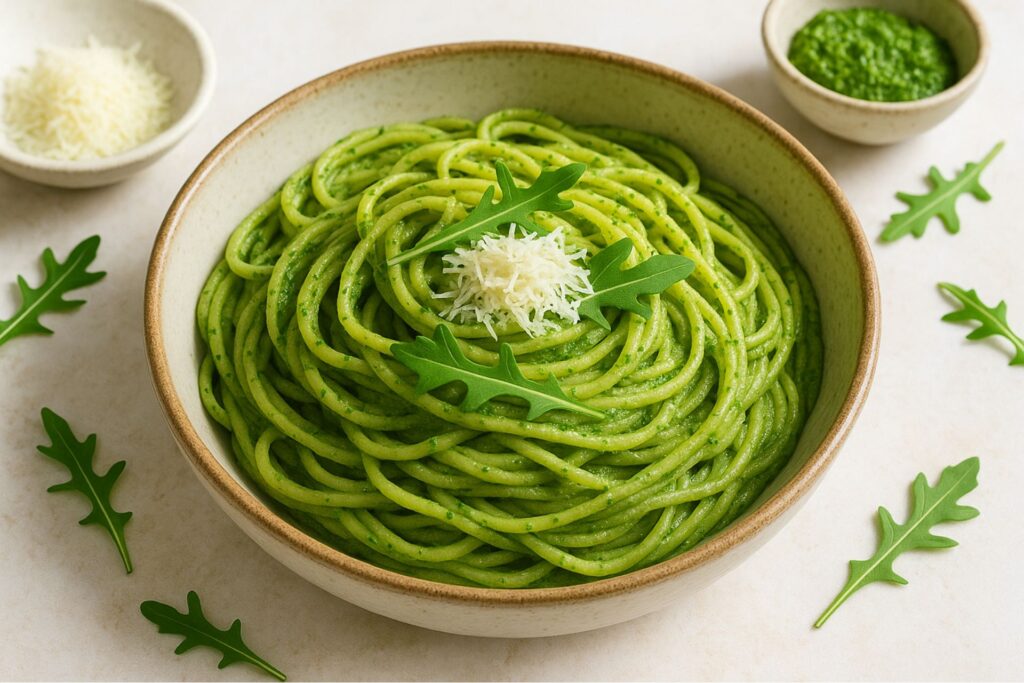Linguine mit Rucola Pesto
Linguine al Pesto di Rucola ist eine aromatische Pasta mit einem würzig-frischen Pesto aus Rucola, Parmesan, Pinienkernen und Olivenöl – schnell zubereitet und voller Geschmack.
Menge für
Portionen
Zutatenliste
- 400 g Linguine
- 100 g frischer Rucola gewaschen, gut abgetropft
- 50 g Parmesan frisch gerieben
- 30 g Pinienkerne geröstet
- 1 Knoblauchzehe geschält
- 100 ml Olivenöl extra vergine kalt gepresst
- 1 Zitrone Abrieb und etwas Saft
- Salz und Pfeffer nach Geschmack
Zubereitung
- In einem großen Topf Salzwasser zum Kochen bringen. Linguine darin nach Packungsangabe al dente kochen. Etwa 100 ml Kochwasser vor dem Abgießen auffangen.400 g Linguine
- Für das Pesto: Rucola, Parmesan, Pinienkerne, Knoblauch, Zitronenabrieb, etwas Zitronensaft, Salz und Pfeffer in einen Mixer geben. Mit Olivenöl begießen und zu einer cremigen Paste verarbeiten. Bei Bedarf etwas vom Nudelkochwasser zufügen, um die Konsistenz zu justieren.100 g frischer Rucola | 50 g Parmesan | 30 g Pinienkerne | 1 Knoblauchzehe | 100 ml Olivenöl extra vergine | 1 Zitrone
- Die abgegossenen Linguine sofort mit dem Rucola-Pesto vermengen. Nach Bedarf noch etwas Kochwasser unterrühren, bis sich das Pesto gleichmäßig verteilt und cremig um die Pasta legt.
- Auf vorgewärmten Tellern anrichten, mit etwas zusätzlichem Parmesan und einigen Rucolablättern garnieren. Sofort servieren.
Tipps & Wissenswertes
Herkunft: Diese moderne Pesto-Variante ist besonders im Süden Italiens beliebt, wo Rucola in vielen Frühlingsgerichten verwendet wird.
Varianten: Statt Pinienkernen eignen sich auch Walnüsse oder Mandeln. Für eine vegane Variante: Parmesan durch Hefeflocken ersetzen.
Lagerung: Pesto kann im Kühlschrank in einem Glas mit etwas Öl bedeckt 2–3 Tage aufbewahrt werden.
Was passt dazu? Ein trockener Weißwein wie Vermentino oder ein spritziger Frizzante. Dazu frisches Ciabatta.
Tipps zum Gelingen: Rucola gut abtropfen lassen, damit das Pesto nicht wässrig wird. Kochwasser nie vergessen – es macht die Sauce cremig!
Wenig Zeit zu kochen? Entdecke unsere schnellsten Pasta Rezepte!
Nährwerte & Eignung
Kalorien687kcal (34%)Kohlenhydrate80g (27%)Protein20g (40%)Fett33g (51%)Gesättigte Fettsäuren6g (30%)Mehrfach ungesättigte Fettsäuren6gEinfach ungesättigte Fettsäuren19gCholesterin9mg (3%)






























